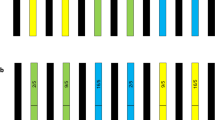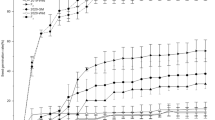Abstract
Glyphosate-resistant (GR) transgenic soybean has never been cultivated commercially in China. It is essential to develop the separation measures required to prevent out-crossing between GR and conventional soybean (Glycine max (L.) Merr.) by characterizing the transgene flow before GR soybean is released. In this study, the transgene flow from a GR transgenic soybean AG5601 to conventional soybeans was characterized. First, natural out-crossing rate was evaluated using 36 conventional soybean varieties interplanted with GR soybean AG5601 transformed with a cp4 EPSPS gene conferring the resistance to herbicide glyphosate in the field in 2007 and 2008 in China. Second, drift distance of cp4 EPSPS gene from GR soybean AG5601 to soybean cv. Zhonghuang13 was evaluated using the progenies harvested from eight directions at different distance. Third, the relationship of gene flow of GR soybean AG5601 with flowering synchronization days or insect pollinators of each variety was analyzed using regression analysis. Thirty-two of 36 tested conventional soybean varieties had surviving progenies after two times of sprays of glyphosate, and 49 of 41,679 progenies were verified to be glyphosate-tolerant heterozygous offspring. The out-crossing rates in positive varieties (having surviving offspring after two times of sprays of glyphosate) ranged from 0.039 to 0.934 %. The farthest distance (drift distance) between soybean AG5601 and cv. Zhonghuang13 at which out-pollinating was still able to be observed was 15 m, with an out-crossing rate of 0.012 %. Regression analysis showed that there was a positive relationship between cross-pollination frequency and flowering synchronization days or pollinator insects. Therefore, when GR soybean is released to the field, it should be critically separated with the conventional soybean in space and cultivation time with efficient insect control during flowering.



Similar content being viewed by others
References
Abud S, de Souza PIM, Vianna GR, Leonardecz E, Moreira CT, Faleiro FG, Junior JN, Monteiro PMFO, Rech EL, Aragao FJL (2007) Gene flow from transgenic to nontransgenic soybean plants in the Cerrado region of Brazil. Genet Mol Res 6(2):445–452
Ahrent DK, Caviness CE (1994) Natural cross-pollination of twelve soybean cultivars in Arkansas. Crop Sci 34:376–378
Caviness CE (1966) Estimates of natural cross pollination in Jackson soybeans in Arkansas. Crop Sci 34:376–378
Cerdeira AL, Duke SO (2006) The current status and environmental impacts of glyphosate-resistant crops: a review. J Environ Qual 35:1633–1658
Chen M, Shelton A, Ye GY (2011) Insect-resistant genetically modified rice in China: from research to commercialization. Annu Rev Entomol 56:81–101 (In Chinese)
Du SZ, Dai QL, Feng B, Wang J (2009) The EPSPS gene flow from glyphosate-resistant Brassica napus to untransgene B. napus and wild relative species Orychophragmus violaceus. Acta Physiologiae Plantarum 31:119–124
Ellstrand NC (2001) When transgenes wander, should we worry? Plant Physiol 125:1543–1545
Ellstrand NC, Prentice HC, Hancock JF (1999) Gene flow and introgression from domesticated plants into their wild relatives. Annu Rev Ecol Evol Syst 30:539–563
Erickson EH (1975) Effect of honey bees on yield of three soybean cultivars. Crop Sci 15:84–86
Fujita R, Ohara M, Okazaki K, Shimamoto Y (1997) The extent of natural cross-pollination in wild soybean (Glycine soja). J Hered 88:124–128
Halsey ME, Remund KM, Davis CA, Qualls M, Eppard PJ, Berberich SA (2005) Isolation of maize from pollen-mediated gene flow by time and distance. Crop Sci 45:2172–2185
Hicks DR (1978) Growth and development. In: Norman AG (ed) Soybean physiology, agronomy and utilization. Academic Press Inc, New York, pp 17–44
Huang JK, Yang J (2011) China’s agricultural biotechnology regulations-export and import considerations. International Food & Agricultural Trade Policy Council, USA, pp 4–31
Hymowitz T (1970) On the domestication of the soybean. Econ Bot 24:408–421
James C (2011) Global status of commercialized biotech/GM crops. ISAAA brief no. 43. ISAAA, Ithaca
Kikuchi A, Murata K, Tabuchi K, Sakai S (1993) Inheritance of seed embryo color and investigation of degree natural cross-pollination in soybeans. Breed Sci 43(Suppl. 2):112
Lipp M, Brodmann P, Pietsch K, Pauwels J, Anklam E (1999) IUPAC collaborative trial study of a method to detect genetically modified soy beans and maize in dried powder. J AOAC Int 82:923–928
Lipp M, Anklam E, Stave JW (2000) Validation of an immunoassay for detection and quantitation of a genetically modified soybean in food and food fractions using reference materials: Interlaboratory study. J AOAC Int 83:920–927
Liu J, Zhou B, Yang CY, Li YR, Jiang LX, Zhang MC, Tao B, Qiu LJ (2012) Gene flowing of genetically modified glyphosate-resistant soybean with EPSPS. Soybean Sci 31(4):517–521 (In Chinese)
Mallory-Smith C, Zapiola M (2008) Gene flow from glyphosate-resistant crops. Pest Manag Sci 64:428–440
Mannion AM, Morse S (2012) Agronomic and environmental considerations and reflections based on 15 years of GM crops. Prog Phys Geogr 36(6):747–763
Murray MG, Thompson WF (1980) Rapid isolation of high molecular weight DNA. Nucleic Acids Res 8:4321–4325
Nelson RJ, Bernard RL (1984) Production and performance of hybrid soybeans. Crop Sci 24:549–553
Prakash CS (2001) The genetically modified crop debate in the context of agricultural evolution. Plant Physiol 126:8–15
Ray JD, Kilen TC, Abel CA, Paris RL (2003) Soybean natural cross-pollination rates under field conditions. Environ Biosaf Res 2:133–138
Snow A (2002) Transgenic crops-why gene flow matters. Nat Biotechnol 20:542
Takagi M (1927) On the frequency of the spontaneous hybridization in soybeans. Jpn J Bot 3(68):197
Wan JM (2011) Research and development status and future strategy of transgenic plants in China. Chin Bull Life Sci 23(2):157–167 (In Chinese)
Yoshimura Y (2011) Wind tunnel and field assessment of pollen dispersal in soybean [Glycine max (L.) Merri.] [J]. J Plant Res 24(1):109–114
Yoshimura Y, Matsuo K, Yasuda K (2006) Gene flow from GM glyphosate-tolerant to conventional soybeans under field conditions in Japan. Environ Biosaf Res 5:169–173
Acknowledgments
The authors thank Prof. Shiming Liu at Southern Illinois University and Dr. Athanas Guzha at Ghent University for critical reading and careful revising of the manuscript. This work was financially supported by the Major Genetically Modified Organisms Breeding Projects of China with the No. of Grants: 2011ZX08011 and 2012ZX08009004.
Author information
Authors and Affiliations
Corresponding author
Additional information
Communicated by S. Abe.
Rights and permissions
About this article
Cite this article
Huang, WK., Peng, H., Wang, GF. et al. Assessment of gene flow from glyphosate-resistant transgenic soybean to conventional soybean in China. Acta Physiol Plant 36, 1637–1647 (2014). https://doi.org/10.1007/s11738-014-1539-3
Received:
Revised:
Accepted:
Published:
Issue Date:
DOI: https://doi.org/10.1007/s11738-014-1539-3




